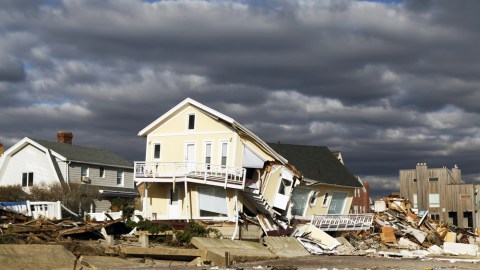Two Technologies that Literally Shone During Sandy’s Darkest Hours

(This post was co-authored by Rory Christian, EDF’s New York smart power director.)
Superstorm Sandy turned New York and New Jersey upside down, causing widespread power failures, destruction and death. The storm cost the region tens of billions of dollars and left millions of residents without light and heat.
In the midst of all that devastation, there were two technologies that literally shone: microgrids and cogeneration.
Microgrids are small-scale distribution systems that link multiple distributed energy resources (DERs) into a network that can generate, store and control its own power. Microgrids can operate in tandem with the main power grid during normal conditions, but can disconnect and function as an independent island if the main grid fails.
Cogeneration (cogen) uses a heat engine or power station to simultaneously generate electricity and useful heat. Like microgrids, cogen plants are able to operate as islands in the event of a grid failure.
During and after Superstorm Sandy, when Con Edison’s electrical grid shut down in Manhattan below midtown, New York University benefited from its cogen plant, which was built in 2011. Once the plant’s controls sensed that power was not flowing from the grid, the plant automatically isolated itself and began operating independently. The 22 buildings connected to NYU’s cogen plant for electricity continued to have power, heat and hot water, then reconnected to the grid once Con Edison was able to restore power.
The Co-op City development, in the northeast corner of the Bronx, had a similar experience. It is the largest single residential development in the United States, home to roughly 50,000 people. In 2009, Co-op City, as part of a major renovation, replaced its power plant with a cogen facility. The cogen plant has the capacity to produce as much as 40 megawatts (MW) of power, enough to meet Co-op City’s electricity demand and generate enough steam to eliminate the need for additional boilers, except in winter. During and after Superstorm Sandy, when the surrounding neighborhoods were without power, Co-op City continued to provide power as well as heat and hot water to its residents.
The point of these examples is that Sandy taught us lessons not only about what couldn’t withstand the storm, but what did work and why. EDF has been contributing to this body of knowledge and we are already seeing progress across the Northeast as decision makers act to make their regions more resilient.
Earlier this month, New Jersey Governor Chris Christie allocated $25 million in federal funds to local governments to develop alternative energy projects designed to make the state’s power infrastructure resilient and reliable during widespread electrical outages. In New York, EDF is working with Governor Cuomo’s administration on establishing a “Green Bank” that would transform clean energy markets by filling market gaps in financing for renewable energy and energy efficiency projects in the state.
It will take time to transform the large and complex power generation industry. But we are beginning to see encouraging movement toward the goal of a cleaner, smarter and stronger energy infrastructure that will not only reduce harmful global warming pollution, but also protect us against future extreme weather events arising from climate change.
To read more about ‘Sandy Success Stories’ visit edf.org/sandysuccessstories.
The article originally appeared on the EDF Voices blog and is reprinted with permission.
Image courtesy of Shutterstock





